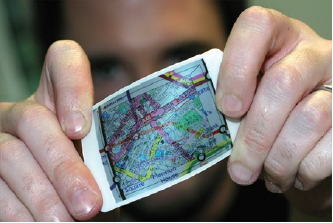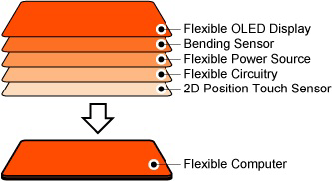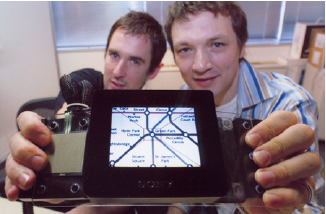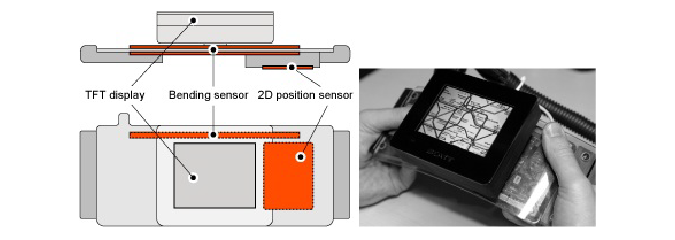ボタンの無い、曲げられるコンピュータ
 斬新なアイデアに満ちたコンピュータGummi
斬新なアイデアに満ちたコンピュータGummi
Gummiは、2001年から2003年にかけて、Ivan Poupyrev、Carsten Schwesig、森 栄二郎によって提案されました。 Gummiは非常に薄く、クレジットカードよりもやや大きいサイズで、ボタンやスイッチは一切ありません。 ユーザは、Gummi本体を両手に持ち、物理的に曲げて前面の柔軟なディスプレイの表示を見ながら、背面で指をスライドさせて操作します。Gummiはボディ全体を使って、インプットとアウトプットを同時に行うコンピュータなのです。
写真提供:Junko Kimiura
Gummi コンセプト誕生の背景
 Gummiは当時の新技術やユーザ意識の徹底的な調査により生まれました。 特に、印刷可能な電池やroll-to-roll式薄膜、フレキシブルトランジスタ、フルカラー高画質のフレキシブル有機ELディスプレイなど、その頃登場した新規の有機電子材料や製造技術の進展が、Gummi開発に拍車をかけました。新たに生まれた材料・製造技術が今後、成熟するに伴って、それを用いて作られるコンピュータデバイスの性質、形状、物理的特性、人々との関わり方が大きく変化することが予見できたからです。 こうして小型で薄型、価格を抑えた曲げられるモバイルコンピューティングデバイス、Gummiのコンセプトが生まれました。
Gummiは当時の新技術やユーザ意識の徹底的な調査により生まれました。 特に、印刷可能な電池やroll-to-roll式薄膜、フレキシブルトランジスタ、フルカラー高画質のフレキシブル有機ELディスプレイなど、その頃登場した新規の有機電子材料や製造技術の進展が、Gummi開発に拍車をかけました。新たに生まれた材料・製造技術が今後、成熟するに伴って、それを用いて作られるコンピュータデバイスの性質、形状、物理的特性、人々との関わり方が大きく変化することが予見できたからです。 こうして小型で薄型、価格を抑えた曲げられるモバイルコンピューティングデバイス、Gummiのコンセプトが生まれました。
Gummiの構造
Gummiにはボタンも機械的可動部分も一切ない代わりに、柔軟性のある電子コンポーネントを層状に積み重ねるというアイデアが盛り込まれています。 前面の有機ディスプレイと背面のポジションセンサーの間に、処理・記憶回路、センサー、電源が挟まれ、その全てが柔軟性をもち曲げ伸ばしが可能です。 タッチセンサーを背面に装備することで、ボタンが不要になり、小さなデバイスでありながら、前面ディスプレイを大きく使うことができます。
Gummiが直面した課題
しかし、このようなコンセプトのデバイスには、機器とのやり取りの面で多くの課題があります。 背面をタッチすることでデバイス前面に表示される画像コンテンツとやり取りするという手法は、使い勝手が良いのか? 本体を曲げながら背面をタッチして操作することは可能なのか? そして、最も重要なのが、ボタン無しに、曲げる操作と背面タッチだけで幅広いタスクを遂行することは可能なのだろうか? これらの課題解決のために生まれたのが、デバイス全体を曲げることで「スイッチ」兼アナログジョイスティックとして使うという発想です。 本体をある程度まで曲げる操作は、「プッシュ」操作と見なされます。これによってズームインとズームアウト、スピード、ポップアップ、画像サイズ等がコントロール可能となります。 曲げがある一定の閾値を超えると「クリック」となり、画像やオペレーションが所定の位置に収まります。 「選択」は、操作したいオブジェクトを背面のタッチセンサーを使用して画面中央に配置することで行えます。 こうした一連の動作により、ウェブブラウジング、ピクチャ表示や地図ナビゲーション、3Dゲームプレイ、テキスト入力まで、非常に幅広い操作が可能になります。 たとえば、地図ナビゲーションの場合、
①背面をタッチして、目標とする場所「駅」などを赤枠で表示された「画面中央」に移動させます。
②全体を曲げて、ズームイン、さらに曲げてストリートモードを選択します。
③平らな状態に戻して、表示を見やすくします。逆方向に曲げると操作を戻すことができます。
Gummiに対する評価
Gummiのコンセプト評価のために、要求される特性のほぼ全てを実現した試作機(曲げられるが、柔軟性はない)で、広範囲の調査を行ないました。 結果、Gummiとのやり取りは使い易くて楽しく、操作感が自然であると評価を得ました。特に背面での操作は、小さな画面を指で隠すことなくやり取りできる技術として好評を博しました。
写真:Gummiのインターフェース評価に使用されたモデル
 Gummiのコンセプトは、インタラクションデザインの分野やHCI(ヒューマンコンピュータインタラクション)研究団体の専門家たちからも世界的な反響を呼びました。著名な国際会議の1つであるCHI 2004においてGummiに関する研究論文が発表され、柔軟性を持つコンピュータのインターフェースの新しい方向性を示しました。 今から10年以上も前、小さなスクリーンと12種類のキー入力が主流であった携帯電話全盛期に考案されたGummiですが、今でも十分先端的で魅力的です。 Gummiで発明した多くの操作技術、何よりも、柔軟性のあるデバイスが市場に登場するのは、まだ先の話でしょう。 しかし、背面タッチユーザーインターフェースは、後の研究に繋がり、その成果の一部がすでに市場に登場してきています。画期的だったボタンのないタッチ操作は、今日のモバイル機器向けインターフェースデザインの一般的なトレンドとなっています。 この意味で、Gummiは、単に未来を見据えているだけでなく、未来を発明し、作り上げていく、真の意味で先見の明のある創案であったといえます。
Gummiのコンセプトは、インタラクションデザインの分野やHCI(ヒューマンコンピュータインタラクション)研究団体の専門家たちからも世界的な反響を呼びました。著名な国際会議の1つであるCHI 2004においてGummiに関する研究論文が発表され、柔軟性を持つコンピュータのインターフェースの新しい方向性を示しました。 今から10年以上も前、小さなスクリーンと12種類のキー入力が主流であった携帯電話全盛期に考案されたGummiですが、今でも十分先端的で魅力的です。 Gummiで発明した多くの操作技術、何よりも、柔軟性のあるデバイスが市場に登場するのは、まだ先の話でしょう。 しかし、背面タッチユーザーインターフェースは、後の研究に繋がり、その成果の一部がすでに市場に登場してきています。画期的だったボタンのないタッチ操作は、今日のモバイル機器向けインターフェースデザインの一般的なトレンドとなっています。 この意味で、Gummiは、単に未来を見据えているだけでなく、未来を発明し、作り上げていく、真の意味で先見の明のある創案であったといえます。
A buttonless, bendable computer
 Gummi brings numerous trail-blazing ideas together
Gummi brings numerous trail-blazing ideas together
In 2001-03, Ivan Poupyrev, Carsten Schwesig and Eijiro Mori proposed Gummi as a concept for a new-age mobile computing device. Ultra-thin and about the size of a credit card, a Gummi computer is stripped bare of buttons and switches. The device can be held in both hands, and bent into various shapes. Users can slide their fingers over the back surface to bring the images and information they want to the screen on the front. By simply using the Gummi body itself, input and output computing operations can be performed at the same time.
Photo: Junko Kimiura
The development of Gummi
 Gummi resulted in large part from active use of the latest technologies at the time, supported by thorough examinations of users’ needs and preferences. Gummi development work accelerated as a raft of new technologies — printable batteries, roll-to-roll thin-film flexible transistors, full-color high-definition organic electroluminescent (EL) displays, etc. — progressed rapidly. The developers recognized that as new materials and their manufacturing technologies matured they would be likely to substantially change the nature of computing devices, and shape the interaction of man and machine. Against this backdrop, the trio hit on Gummi, as the realization of a compact, thin, cost-effective and bendable mobile computer.
Gummi resulted in large part from active use of the latest technologies at the time, supported by thorough examinations of users’ needs and preferences. Gummi development work accelerated as a raft of new technologies — printable batteries, roll-to-roll thin-film flexible transistors, full-color high-definition organic electroluminescent (EL) displays, etc. — progressed rapidly. The developers recognized that as new materials and their manufacturing technologies matured they would be likely to substantially change the nature of computing devices, and shape the interaction of man and machine. Against this backdrop, the trio hit on Gummi, as the realization of a compact, thin, cost-effective and bendable mobile computer.
The structure of Gummi
Gummi, while stripped of buttons and other mechanical moving parts, employs flexible electronic components arranged in layers. In between the organic display on the front and the position sensor on the back are processing and storage circuits, sensors and the power source, all flexible enough to allow for a bendable and expandable device. By installing a touch sensor on the back the design became button-less and the front screen could remain large relative to the size of the device.
Challenges
Computing devices built on the Gummi concept faced many challenges, particularly in the area of human-machine interaction. Is it really user-friendly to bring contents to a front display by touching the back? Could it become possible to run the device by bending it to touch the back? Most importantly, can a button-less device execute a multitude of tasks? These questions nagged at the developing team. To solve these questions, the trio explored the possibility of a bendable device that could function as a switch and an analog joystick simultaneously. Gummi technology holds that bending the device, to some degree, is equivalent to "pushing," which makes it possible to control zoom-in (and zoom-out), speed, popup and image size. If bending exceeds a certain level, the device becomes “clicked,” a step that brings an image directly to the required position. To “choose” an object, it will be placed in the center of the screen by using the touch sensor on the rear. By following this sequence, you can execute a range of operations—among them, Web browsing, picture display, map navigation, 3D game playing and texting. To execute map navigation, for example, you
① touch the back and move the target, (for example, a railway station), to the center of the screen (shown in a red frame);
② bend the device to zoom in on the location. bend further and choose the street mode; then,
③ return the device to its natural flat condition to make the display easier to read (Note: By bending the device in the opposite direction, the operation will proceed in reverse.
Evaluation of Gummi
An extensive performance test was conducted on an experimental model (a bendable but not fully flexible model) that met almost all the characteristics required for Gummi. This model was found to excel in user-machine interface – it was easy to use and maneuverable. Particularly highly rated as a technology was the approach of placing the operational controls on the back of the device, because this kept the display screen free from the intrusion of fingers.
Photo: An experimental model used to study Gummi's interface
 Gummi's concept received rave reviews internationally from scientists and groups working in the field of interface design and human-computer interaction. One study presented at the CHI 2004 Conference on Human Factors in Computing Systems indicated a direction in which bendable computer interfaces would develop in the future. Gummi dates back more than 10 years, when mobile phones were in their prime. Dominant then were models that had small screens and 12 keyboard entries. This still is at the forefront of mobile phone design and has lost none of its luster. Many years may still pass before computing approaches and devices based on Gummi technology hit the market. And yet Gummi triggered various research efforts in subsequent years due to, the concept of an interface based on touching the rear surface of the device. Some results of this research already have been translated into commercial models. The button-less device operation, for example, has now established itself as a standard interface for various types of mobile equipment. Given this, it is clear that Gummi was not just another idea for the future; it also was an approach to "inventing and creating" the future. This prescient concept was one of the few that saw the mobile revolution. coming.
Gummi's concept received rave reviews internationally from scientists and groups working in the field of interface design and human-computer interaction. One study presented at the CHI 2004 Conference on Human Factors in Computing Systems indicated a direction in which bendable computer interfaces would develop in the future. Gummi dates back more than 10 years, when mobile phones were in their prime. Dominant then were models that had small screens and 12 keyboard entries. This still is at the forefront of mobile phone design and has lost none of its luster. Many years may still pass before computing approaches and devices based on Gummi technology hit the market. And yet Gummi triggered various research efforts in subsequent years due to, the concept of an interface based on touching the rear surface of the device. Some results of this research already have been translated into commercial models. The button-less device operation, for example, has now established itself as a standard interface for various types of mobile equipment. Given this, it is clear that Gummi was not just another idea for the future; it also was an approach to "inventing and creating" the future. This prescient concept was one of the few that saw the mobile revolution. coming.



